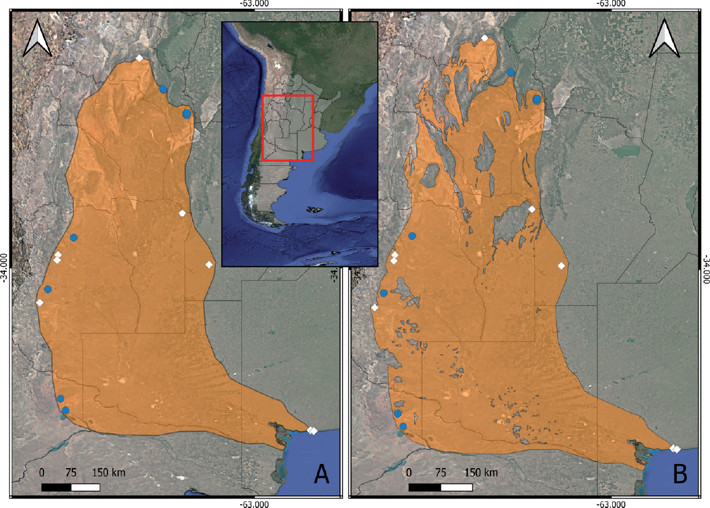New records and distribution adjustments of the pink fairy armadillo (Chlamyphorus truncatus, Xenarthra: Chlamyphoridae) based on ecological requirements
DOI:
https://doi.org/10.31687/SaremNMS25.1181Keywords:
Argentina, armadillo, Cingulata, citizen science, endemism, pink fairy armadilloAbstract
This study presents ten new occurrence records of Chlamyphorus truncatus (Harlan, 1825) that expand the known range of its distribution. These records were obtained from different sources, such as citizen science (interviews, social media), scientific collections, and bibliography. These results allow us to update its distribution map, incorporating edaphic variables that constrain its range. The new records are located in the Provinces of Catamarca (6), Mendoza (2), and Neuquén (2), highlighting the importance of citizen science and the ecological requirements of the pink fairy armadillo. This information provides key insights for future research and conservation strategies.
References
Abba, A. M., & S. F. Vizcaíno. 2011. Distribución de los armadillos (Xenarthra: Dasypodidae) en la provincia de Buenos Aires, Argentina. Mastozoología Neotropical 18(2):185–206.
Borghi, C. E., C. M. Campos, S. M. Giannoni, V. E. Campos, & C. Sillero-Zubiri. 2011. Updated distribution of the pink fairy armadillo Chlamyphorus truncatus (Xenarthra, Dasypodidae), the world's smallest armadillo. Edentata 12:14–19.
Delsuc, F., M. Superina, M. K. Tilak, E. J. Douzery, & A. Hassanin. 2012. Molecular phylogenetics unveils the ancient evolutionary origins of the enigmatic fairy armadillos. Molecular Phylogenetics and Evolution 62:673–680. https://doi.org/10.1016/j.ympev.2011.11.008.
Delfino Ahumada, H., M. Pfoh, R. Montero, D. Ciai, J. Negrete, & E. Soibelzon. 2023. La ciencia ciudadana como herramienta para el estudio de especies crípticas: el caso del pichiciego (Chlamyphorus truncatus; Xenarthra: Chlamyphoridae). VII Congreso Nacional de Conservación de la Biodiversidad, Puerto Iguazú.
Dietrich, J. R. 1995. El uso de entrevistas para averiguar la distribución de vertebrados. Revista de Ecología Latinoamericana 2:1–4.
Follett, R., & V. Strezov. 2015. An analysis of citizen science based research: usage and publication patterns. PLoS ONE 10:e0143687. https://doi.org/10.1371/journal.pone.0143687.
INTA. 1990. Portal INTA digital Geo. <https://geo-backend.inta.gob.ar/catalogue/uuid/c36f1b00-fc0b-414e-b820-fb71c7c2faf3>.
Krmpotic, C. M., et al. 2024. The double skin of the pink fairy armadillo, the peculiar integumentary system of Chlamyphorus truncatus Cingulata (Mammalia, Xenarthra). Journal of Zoology 322:203–220. https://doi.org/10.1111/jzo.13136.
Marshall, S. K., M. Superina, K. B. Spainhower, & M.T. Butcher. 2021. Forelimb myology of armadillos (Xenarthra: Cingulata, Chlamyphoridae): anatomical correlates with fossorial ability. Journal of Anatomy 238:551–575. https://doi.org/10.1111/joa.13326.
Morello, J., S. D. Matteucci, A. F. Rodríguez, & M. E. Silva. 2018. Ecorregiones y complejos ecosistémicos argentinos. 2ª edición ampliada. Orientación Gráfica Editora, Buenos Aires.
Morici, A. 2011. Nuevo registro de pichiciego menor (Chlamyphorus truncatus) para la provincia de Buenos Aires, Argentina. Biológica: Naturaleza, Conservación y Sociedad 14:77–78.
Nevo, E. 1979. Adaptive convergence and divergence of subterranean mammals. Annual Review of Ecology and Systematics 10:269–308. https://doi.org/10.1146/annurev.es.10.110179.001413.
Nevo, E. 1995. Mammalian evolution underground. The ecological-genetic-phenetic interfaces. Acta Theriologica 40:9–31.
Soibelzon, E., et al. 2021. El pichiciego (Chlamyphorus truncatus) nuevos datos ecológicos y de distribución. Jornadas Argentinas de Mastozoología: 168. <https://www.sarem.org.ar/wp-content/uploads/2021/04/SAREM_Resumenes-e-JAM.21_2021.pdf>.
Soibelzon, E., H. Delfino Ahumada, R. Montero, D. Ciai, & J. Negrete. 2023. Nuevos datos biológicos sobre el pichiciego (Chlamyphorus truncatus; Xenarthra: Chlamyphoridae). Jornadas Argentinas de Mastozoología: 128. <https://www.sarem.org.ar/wp-content/uploads/2021/04/SAREM_Resumenes-XXXIV-JAM_2023.pdf>.
Superina, M., et al. 2019. Chlamyphorus truncatus. Categorización 2019 de los Mamíferos de Argentina según su riesgo de extinción. Lista Roja de los mamíferos de Argentina (SAyDS–SAREM, eds.). https://doi.org/10.31687/SaremLR.19.043.
Torres, R., A. M. Abba, & M. Superina. 2015. Climate fluctuations as a cause of rarity in fairy armadillos. Mammalian Biology 80:452–458.
Whittaker, R. H., S. A. Levin, & R. B. Root. 1973. Niche, habitat, and ecotope. The American Naturalist 107:321–38.

Downloads
Published
How to Cite
Issue
Section
License
Copyright (c) 2025 Habib Delfino Ahumada, Esteban Soibelzon

This work is licensed under a Creative Commons Attribution-NonCommercial 4.0 International License.

